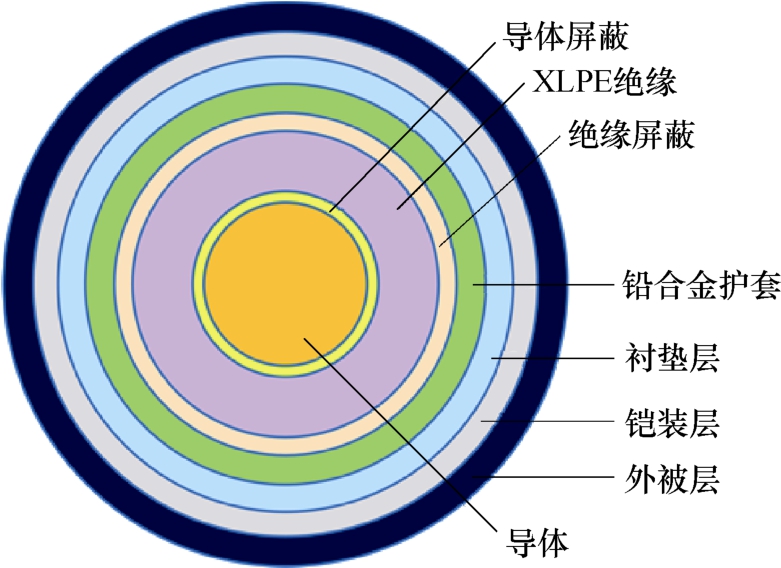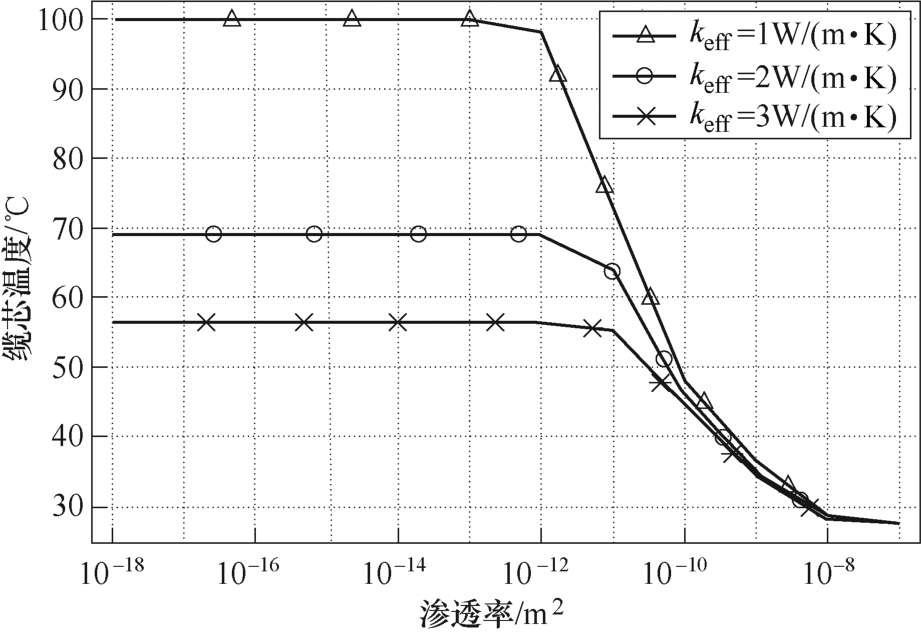0 引言
近年来,随着各国对能源脱碳的重视,海上风电以其能量效益高、适于集中开发等优势,逐渐成为能源转型的重点方向之一[1]。截止2020 年底,全球海上风电累计装机容量已高达40 GW 左右[2]。我国虽然海上风能资源丰富且靠近东部电力负荷中心,但由于海上风电的关键技术研发与商业化进程起步较晚,因此海上风电开发程度明显低于欧洲国家[3-5]。当前我国海上风能开发正面临建设成本高、技术难度大等一系列挑战,其中跨海大规模高效输电是需要探索的关键问题之一[6]。高压海底电缆是海上风电传输系统的重要组成部分,所以构建精确的多场耦合模型,准确分析海底电缆与周围媒质间的传热过程,对于充分发挥其载流能力,提高海上风电系统的经济性具有重要意义。
研究表明,海底电缆的运行环境与陆地电缆存在较大差异[7],其中最明显的区别在于海底电缆与周围媒质的传热过程不仅包含热传导还涉及更为复杂的对流换热过程[8-9]。然而目前对于海底电缆温度场和载流特性的研究主要是借鉴陆地电缆研究中普遍采用的热路模型和有限元法。文献[10]基于热路模型,讨论了三芯海底电缆内部光纤与导体温度的关系;文献[11]研究了电缆绝缘层厚度对其温度场分布的影响;文献[12]构建了海底电缆的电-热-流耦合模型,分析了上层海水流动对电缆载流量的影响;文献[13]研究了不同敷设条件下海底电缆的传热特性;文献[14]基于电缆热平衡模型,结合海底电缆的热惯性,讨论了海底电缆的载流能力。此外还有学者参考陆地电缆的分析方法对海底电缆的载流特性提升进行了初步研究[15-17]。但上述文献中采用的IEC 热路模型忽略了海水的对流换热过程,得出的电缆载流量比较保守,导致海底电缆的建设成本大幅增加;部分学者虽然采用了较为精确的有限元法,但仍未能精确模拟海床沙土的多孔介质特性,忽略了多孔介质与海水间的复杂对流换热过程及其渗透率参数对整体换热过程的影响,从而导致海底电缆的载流性能分析存在较大误差,影响海上风电系统经济性和交流海底电缆输送能力的评估。
综合来看,现有计算模型难以精确分析海底电缆的温度场分布和载流特性。因此,本文计及海床沙土的多孔介质特性及海水与多孔介质间的对流换热过程,构建了海底电缆的电-磁-热-流多物理场耦合分析模型;将电缆敷设的下层沙土从普遍简化的没有孔隙的紧实固体,等效为允许海水流动的多孔介质进行模拟。并在此基础上,详细分析了海底敷设条件下多孔介质对电缆换热过程的影响,分析了不同渗透率下电缆周围多孔介质中的流体场、温度场及对流换热强度;研究了渗透率、导热系数、电缆埋深、三相间距等因素对缆芯温度的影响;并通过和IEC 计算结果对比,讨论了渗透率对海底电缆载流性能的重要影响。
1 海底电缆多物理场耦合模型
1.1 海底电缆多物理场耦合数学模型
在上覆海水的压力作用下,海床沙土实际是处于饱和状态下的多孔介质,如图1 所示,其中固体成分是沙土颗粒,流体成分主要是海水,由此导致海底电缆温度场分析涉及三个环节,即固体(电缆本体)传导、液体(海水)对流、多孔介质(饱和沙土)的传导和对流过程,而电缆的电磁损耗是整体热源所在,是多场耦合的内在驱动,因此海底电缆热特性和载流量分析本质上是电、磁、热及流体的多物理场耦合问题。

图1 海底电缆运行环境
Fig.1 Cable operation environments
多物理场间的耦合关系如图2 所示,缆芯中的电流引起电磁损耗,并导致电缆及周围介质中的温度变化,温度变化则进一步影响电缆周围的流体场分布;而流速变化又反过来影响温度场分布,进而影响缆芯电导率、载流量和电缆损耗,如此往复,最终达到动态平衡状态。

图2 多物理场耦合示意图
Fig.2 Schematic diagram of multiphysics coupling
在海缆的电-磁-热-流多物理场耦合过程中,电磁场量满足方程

式中, 为磁场强度矢量相量(A/m);
为磁场强度矢量相量(A/m); 为电场强度矢量相量(V/m);σ 为电导率(S/m);ω 为角频率(rad/s);ε 为介电常数(F/m),μ 为磁导率(H/m)。
为电场强度矢量相量(V/m);σ 为电导率(S/m);ω 为角频率(rad/s);ε 为介电常数(F/m),μ 为磁导率(H/m)。
引入相量形式的矢量磁位 ,上述方程可以转化为频域下的二阶偏微分方程[18]为
,上述方程可以转化为频域下的二阶偏微分方程[18]为
由上述方程得出矢量磁位 之后,即可进一步求得感应电压以及电缆各部分损耗。将电磁损耗作为热源约束与电缆本体的固体传热过程相耦合,得到
之后,即可进一步求得感应电压以及电缆各部分损耗。将电磁损耗作为热源约束与电缆本体的固体传热过程相耦合,得到
式中,c1 为固体材料常压下的比定压热容[J/(kg·K)];k 为导热系数[W/(m·K)];Q1 为热源产生的单位体积的热量(W/m3),即电缆损耗产生的热量;θ 为温度(K);ρ1 为固体材料密度(kg/m3)。
上层海水速度场应满足动量和质量守恒方程[19],即

式中,ρ2 为流体介质的密度(kg/m3);v1 为上层海水的速度矢量(m/s);I 为单位矩阵;μk 为动力粘度(Pa·S);p 为压强(Pa)。
采用Boussinesq 近似等效,方程式(4)可简化为

式中,g 为重力加速度(m/s2);θ0 为初始温度(K)。将式(5)求得的海水速度和密度分布代入流体传热方程式(6),即可得到海水的温度场分布[20]。

式中,c2 为海水常压下的比定压热容[J/(kg·K)];q为热通量(W/m2);Q2 为通过海床上表面传递过来的单位体积的热量(W/m3)。
电缆与多孔介质之间的热交换过程更为复杂,稳态情况下,多孔介质中热传递过程满足约束方程式(7);同时,有实验结果表明,多孔介质的等值导热系数可根据海水与沙土的比例进行近似估算,如式(7)所示[21]。

式中,ρ3 和cp 分别为恒定压力下多孔介质的密度(kg/m3)和比定压热容[J/(kg·K)];keff 为多孔介质的等效导热系数[W/(m·K)],由多孔介质区域中固体和流体部分的导热系数估算得到;kf 和ks 分别为流体与固体的导热系数[W/(m·K)];n 为孔隙度,即孔隙体积占总体积的比例;v2 为多孔介质中的流体速度(m/s),可通过求解Darcy-Brinkman 方程获得。即

式中,kp 为渗透率;β 为流体热膨胀系数(1/K);Qbr 为质量源成分[kg/(m3·s)],表征域内的质量沉积或质量生成。
式(3)、式(6)、式(7)决定了电缆本体、海水及饱和沙土中的温度场分布,而此温度反过来又影响电缆电磁损耗及与周围介质的传热过程,这是因为一方面电缆实际运行过程中,缆芯和金属护套的电导率均受温度影响,其与温度的函数关系如式(9)所示;另一方面流体速度和温度之间存在强耦合关系,如式(5)、式(8)所示。

式中,σ20 为20℃时缆芯导体电导率(S/m);α 为导体的电阻温度系数(1/K);θ 为缆芯实际温度(K)。
1.2 海底电缆多物理场耦合仿真模型
本文以220 kV 交联聚乙烯(Cross-Linked Polyethylene,XLPE)单芯铠装海底电缆为研究对象,其结构如图3 所示,参数见表1。海缆金属护套两端直接接地、无换位,埋深为1 m,其仿真模型如图4 所示。

图3 电缆分层结构示意图
Fig.3 Schematic diagram of cable layered structure
表1 电缆物理参数
Tab.1 Cable physical parameters


图4 海底电缆仿真模型
Fig.4 The simulation model for submarine cables
为精确模拟电缆周围的流体场和温度场分布,本文将仿真场域设置为50 m×40 m 的矩形区域,海水层高度为15 m,模型所施加的边界条件如图5 所示。图5 中,n0 为场域边界法向单位矢量;λ 为表面传热系数;θa 为场域上、下边界温度;p0 为场域上边界压强,p1 为场域右边界压强。

图5 模型边界条件
Fig.5 Schematic diagram of the boundary conditions
2 渗透率对海底电缆载流量的影响
2.1 多孔介质渗透率
由于饱和沙土、海水是主要传热介质,因此沙土的孔隙度、渗透率及海水的温度、流速对电缆温度场分布有显著的影响。多孔介质的渗透率可根据Kozeny-Carman 方程进行估算,依据孔隙度与颗粒尺寸,可按式(10)得到相应的渗透率。颗粒尺寸变化范围如图6 所示。

图6 颗粒尺寸变化范围
Fig6 Range of particle size variation

式中,dm 为考虑颗粒大小概率分布的平均颗粒尺寸;n 为孔隙度,其取值范围为0.3~0.6,本文分析时将下层沙土视为允许海水流动的孔隙度n 为0.4的多孔介质以模拟随机堆积颗粒的影响;渗透率取值范围为10-18~10-7 m2[21]。
2.2 渗透率对海底直埋电缆载流量的影响
海底直埋电缆被沙土紧密包围,受渗透率影响较大,因此本文着重此种情况。图7 为以压力水头描述的缆芯间距25 cm 时不同渗透率下沙土中的压力分布情况,流线表示沙土中海水流动方向。可以看到渗透率高的情况下,压力水头较小,流速的垂直分量更大,沙土中涡流的位置明显上移。即沙土中的海水在电缆垂直方向上产生了较为强烈的对流过程,由此引起的电缆与上层海水间的传热过程更为剧烈,从而改善温度场分布,有利于提升电缆载流量。

图7 渗透率对压力水头和流速的影响
Fig7 Influence of permeability on pressure head andvelocity
图8 为不同渗透率下的温度场分布,箭头表示沙土中海水流向,与图7 中流线表示的含义相同。可以看出,随着渗透率增大,电缆温度显著降低,这是因为高渗透率在垂直方向上引起的对流热交换过程更加剧烈,由此带走大量热量,导致电缆温度更低。

图8 渗透率对温度分布及沙土渗流的影响
Fig.8 Influence of permeability on temperature distribution and sand seepage
图9 为孔隙度和渗透率对电缆垂直方向对流换热强度的影响,可以看出,对流换热的强度主要与渗透率有关;当渗透率较大时,饱和沙土中的海水循环流动加强,导致电缆与上层海水间能够通过对流换热交换大量热量。缆芯温度随渗透率与孔隙度的变化趋势如图10 所示。而从图10 中可以看出,当渗透率较小时,随着孔隙度的增加,缆芯的温度逐渐升高。这是由于此时海水中的热传导占主要地位,而海水的导热系数小于沙土,因此,孔隙度越大,电缆周围海水越多,等效的导热系数越低。当渗透率较高时,缆芯温度基本不再受孔隙度的影响,说明此时对流换热占电缆传热过程中的主导地位。不同的渗透率通过影响饱和沙土中的对流强度对高压海底电缆的传热过程影响明显。渗透率大小决定了电缆周围的传热过程主要是热传导还是对流换热。

图9 电缆垂直方向对流换热强度
Fig.9 Convective heat transfer intensity in vertical direction of cable

图10 缆芯温度随渗透率与孔隙度的变化趋势
Fig.10 Cable core temperature changes with permeability and porosity
三相电缆作为整个系统的热源,向外传递热量的同时,其相间同样存在热交换过程,此时缆芯间距将影响三相电缆温度场分布,如图11 所示,可以看出,当沙土渗透率小于10-12 m2 时,缆芯间距对温度的影响较大。而当沙土渗透率较大时,缆芯间距对温度的影响几乎可以忽略。究其原因在于渗透率较小时,热传导占热交换过程的主导地位。此时缆芯间距必然影响传热过程,间距越大越利于散热,缆芯温度越低。随着渗透率的上升,电缆主要通过对流传热进行热量交换,热传导居于次要地位,所以缆芯间距对温度的影响变弱。

图11 不同缆芯间距下渗透率对缆芯温度的影响
Fig.11 Variation of core temperature with permeability under different cable core spacing
图12 为电缆埋深对缆芯温度的影响。可以看出,当沙土渗透率大于10-12 m2 时,埋深对缆芯温度基本无影响。而当沙土渗透率小于10-12 m2 时,缆芯温度随埋深的增加而显著增加。这是因为渗透率较大时,热交换主要依靠对流换热完成,与电缆埋深无关。而当渗透率较小时,热传导过程占主导,随着电缆与海床距离的增大,电缆与上层海水间的热交换将被抑制,导致缆芯温度明显上升。

图12 不同埋深下渗透率对缆芯温度的影响
Fig.12 Variation of core temperature with permeability at different depths
在之前的分析中,沙土导热系数均设定为1 W/(m·K)。现改变沙土导热系数取值,研究其对缆芯温度的影响,不同沙土导热系数下渗透率对缆芯温度的影响如图13 所示。由图13 可知,当渗透率小于10-12 m2 时,导热系数越大,缆芯温度越低,渗透率对温度基本没有影响。这是由于在沙土渗透率较低的情况下,热传导占主要地位,温度分布对沙土导热系数的变化较为敏感,较大的导热系数利于散热所以缆芯温度较低。而当渗透率大于10-12 m2时,渗透率越大,缆芯温度越低,导热系数对温度影响变小,不同沙土导热系数下的温度分布在较高渗透率下趋于一致。其原因在于此时对流换热对热交换过程起决定作用,渗透率越大,对流换热强度越大,缆芯温度越低。

图13 不同沙土导热系数下渗透率对缆芯温度的影响
Fig.13 Variation of cable core temperature with permeability under different thermal conductivity of sandy
图14 为本文载流量计算结果与IEC 标准的比较,可以看出,在电缆周围沙土具有较高渗透率的情况下,电缆的载流量将获得一个较大的提升;在周围介质的渗透率较低的情况下,海底电缆的载流量与IEC 标准基本相同,有时甚至比陆地直埋电缆还要低。这是由于渗透率较低的粘土等多孔沉积物的导热效果甚至低于陆地土壤,使缆芯温度高于其在陆地环境下的设计温度(90 ℃)。

图14 基于多物理场模型及基于IEC 标准的载流量
Fig.14 The cable ampacity respectively based on multiple physical field model and IEC standard
3 结论
本文提出了海底电缆的电-磁-热-流多物理耦合模型,分析了多孔介质对海底电缆温度场分布及载流量的影响,得出如下结论:
1)现有计算方法忽略或低估了海底电缆周围存在的对流换热过程,导致载流量计算值比较保守。
2)多孔介质的渗透率对海底电缆的换热过程和载流特性有显著影响,当渗透率大于10-12 m2 时,电缆周围介质中对流换热过程占主导地位,海底电缆的载流量较陆地电缆得到较大幅度提升。
3)当渗透率小于10-12 m2 时,电缆周围介质中主要发生热传导,此时海底电缆的温度场及载流量和陆地电缆相似。
[1] 宋子秋,刘吉臻,胡阳,等.考虑冰载荷的近海固定桩风电机组运行特性建模与分析[J].中国电机工程学报,2021,41(12): 4144-4152.
Song Ziqiu,Liu Jizhen,Hu Yang,et al.Modeling and analysis of bottom fixed platform offshore wind turbine under ice loads[J].Proceedings of the CSEE,2021,41(12): 4144-4152.
[2] 蔡旭,杨仁炘,周剑桥,等.海上风电直流送出与并网技术综述[J].电力系统自动化,2021,45(21):2-22.
Cai Xu,Yang Renxin,Zhou Jianqiao,et al.Review on offshore wind power integration via DC transmission[J].Automation of Electric Power Systems,2021,45(21): 2-22.
[3] 张静,高冲,许彬,等.海上风电直流并网工程用新型柔性直流耗能装置电气设计研究[J].中国电机工程学报,2021,41(12): 4081-4090.
Zhang Jing,Gao Chong,Xu Bin,et al.Research on electrical design of novel flexible DC energy consuming device for offshore wind power DC grid connection project[J].Proceedings of the CSEE,2021,41(12): 4081-4090.
[4] 杨悦,李国庆.基于VSC-HVDC 的海上风电小干扰稳定控制[J].电工技术学报,2016,31(13): 101-110.
Yang Yue,Li Guoqing.The small signal stability control of offshore wind farm based on VSCHVDC[J].Transactions of China Electrotechnical Society,2016,31(13): 101-110.
[5] 高晨,赵勇,汪德良,等.海上风电机组电气设备状态检修技术研究现状与展望[J].电工技术学报,2022,37(增刊1): 30-42.
Gao Cheng,Zhao Yong,Wang Deliang,et al.Research status and prospect of condition based maintenance technology for offshore wind turbine electrical equipment[J].Transactions of China Electrotechnical Society,2022,37(S1): 30-42.
[6] 刘士利,罗英楠,刘宗烨,等.基于电磁-热耦合原理的三芯铠装电缆在低频输电方式下的损耗特性研究[J].电工技术学报,2021,36(22): 4829-4836.
Liu Shili,Luo Yingnan,Liu Zongye,et al.Study on loss characteristics of three core armored cable under lowfrequency transmission mode based on electromagneticthermal coupling principle[J].Transactions of China Electrotechnical Society,2021,36(22): 4829-4836.
[7] Zhang Lianqiang,He Yifan,Liu Yuancheng,et al.Temperature analysis based on multi-coupling field and ampacity optimization calculation of shore power cable considering tide effect[J].IEEE Access,8:119785-119794.
[8] Ruddy J,Meere R,O’Loughlin C,et al.Design of VSC connected low frequency AC offshore transmission with long HVAC cables[J].IEEE Transactions on Power Delivery,2018,33(2): 960-970.
[9] 陆莹,范明明,郑明,等.基于电磁-热-流耦合场的非开挖敷设方案的海底电缆载流量计算[J].广东电力,2020,33(5): 117-124.
Lu Ying,Fan Mingming,Zheng Ming,et al.Calculation of ampacity for submarine cables under trenchless laying method based on electromagneticthermal-flow coupled field[J].Guangdong Electric Power,2020,33(5): 117-124.
[10] 吕安强,寇欣,尹成群,等.三芯海底电缆中复合光纤与导体温度关系建模[J].电工技术学报,2016,31(18): 59-65.
Lü Anqiang,Kou Xin,Yin Chengqun,et al.Modeling of temperature relation between optical fiber and conductor in 3-core submarine power cable[J].Transactions of China Electrotechnical Society,2016,31(18): 59-65.
[11] 魏艳慧,郑元浩,龙海泳,等.绝缘层厚度对高压直流电缆电场和温度场分布的影响[J].电工技术学报,2022,37(15): 3932-3940.
Wei Yanhui,Zheng Yuanhao,Long Haiyong,et al.Influence of insulation layer thickness on electric field and temperature field of HVDC cable[J].Transactions of China Electrotechnical Society,2022,37(15):3932-3940.
[12] 郝艳捧,陈云,阳林,等.高压直流海底电缆电-热-流多物理场耦合仿真[J].高电压技术,2017,43(11):3534-3542.
Hao Yanpeng,Chen Yun,Yang Lin,et al.Coupled simulation on electro-thermal-fluid multiple physical fields of HVDC submarine cable[J].High Voltage Engineering,2017,43(11): 3534-3542.
[13] Zhang Yiyi,Chen Xiaoming,Zhang Heng,et al.Analysis on the temperature field and the ampacity of XLPE submarine HV cable based on electro-thermalflow multiphysics coupling simulation[J].Polymers,2020,12(4): 952.
[14] 王孟夏,周生远,杨明,等.计及海底电缆热特性的可接纳海上风电装机容量评估方法[J].电力系统自动化,2021,45(6): 195-202.
Wang Mengxia,Zhou Shengyuan,Yang Ming,et al.Assessment method for acceptable installed capacity of offshore wind farms considering thermal characteristics of submarine cables[J].Automation of Electric Power Systems,2021,45(6): 195-202.
[15] 张磊,俞恩科,陈国志,等.提升海底电缆载流量的 2 种方法及其试验研究[J].高电压技术,2015,41(8): 2716-2722.
Zhang Lei,Yu Enke,Chen Guozhi,et al.Two methods for upgrading ampacity of submarine cables and their experimental study[J].High Voltage Engineering,2015,41(8): 2716-2722.
[16] Matine A,Drissi-Habti M.On-coupling mechanical,electrical and thermal behavior of submarine power phases[J].Energies,2019,12(6): 1009.
[17] Giussani L,Rienzo L D,Bechis M,et al.Computation of armor losses in AC submarine cables[J].IEEE Transactions on Power Delivery,2021,36(5): 3014-3021.
[18] 俞集辉.电磁场原理: 电气工程及其自动化专业系列教材[M].2 版.重庆: 重庆大学出版社,2007.
[19] 严俊,王海军,杨阳.多孔介质多场耦合数学模型及其应用[M].北京: 中国水利水电出版社,2018.
[20] 刘伟,范爱武,黄晓明.多孔介质传热传质理论与应用[M].北京: 科学出版社,2006.
[21] Liu Wei.Theory and application of heat and mass transfer in porous media[M].Beijing: Science Press,2006.